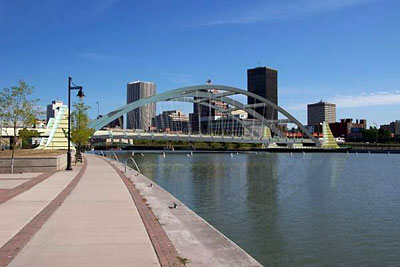Troup Howell Bridge Replacement Project Reduces Injury and Illness Rates and Promotes a Positive Safety and Health Culture
Background:
The Troup Howell Bridge Replacement Project (Partnership), located in Rochester, NY, began in the spring of 2004 and was completed in July 2007. The project involved replacing an existing bridge with a new tiered-arch bridge over water while maintaining existing heavy traffic flow. There were three main stages of the project:
- Stage 1 consisted of building new foundations under the existing bridge, constructing traffic crossovers, and building a new entrance ramp.
- Stage 2 consisted of removing the existing south bridge and rebuilding a new south side of the structure.
- Stage 3 consisted of removing the existing north bridge and rebuilding a new north side of the structure.
Success Impact:
Over the entire duration of the project, there were only two lost time work injuries, and over the last year and a half of the project there were none. The project took 186,455 man hours to complete and 104,216 hours were completed with no loss time injuries. This is significant due to much of the work being conducted over water in extreme weather conditions.
Injury and Illness Rates Decline - Days Away, Restricted and Transfer (DART)
Over the three years of the Partnership, the DART rate steadily decreased, with the average for Year 1 being 5.0. The DART rate was almost cut in half during the second year, and was 0.0 in the final year. The average for the three years was 2.1 compared to the BLS industry national average of 3.5.
| DART | |
|---|---|
| Year 1: | 5.0 |
| Year 2: | 2.9 |
| Year 3: | 0.0 |
| 3-Year Rate (Avg.) | 2.1 |
| BLS Industry National Average for most recent year | 3.5 |
Also during the project, worker compensation costs were 16 cents less per hour than the national industry average.
Safety and Health Culture Enhanced
The general contractor for the site, Edward Kraemer & Sons, Inc., implemented two safety programs during the project. The first program was the behavioral safety program "BOSS" (Behavioral Observation Safety System). Under BOSS, supervisory employees made continual behavioral-based observations and conducted an intervention for any at risk behaviors noted.
The second program was the "TEAM" (Total Efficiency Attainment Meeting) program. Each foreman conducted a daily TEAM meeting with his crew where work activities, material and equipment needed, hazards and methods of mitigating them for the work were discussed. Dialogue during these meetings with the crew included methods, production rates/goals, safety, and any inspection items or incidents from the previous day.
Partnership Objectives:
The Partnership was formed to eliminate hazards and reduce injuries resulting from the four focused construction hazards (falls, struck-by, caught-in\between, and electrocutions). Specifically, the Partnership wanted to have a Days Away, Restricted and Transfer (DART) rate that was less than the Bureau of Labor Statistics (BLS) data available for the most recent year. Other objectives included having a strong emphasis on training for both supervisors and non-supervisory employees, promoting safety and health programs, and encouraging a positive change within the local construction industry.
- Origin: Region 2, Buffalo Area Office
- Partners: EDWARD KRAEMER & SONS, INC., OSHA Region 2 - Buffalo Area Office, the NYS Department of Labor Consultation Program, the Rochester Building and Construction Trades Council AFL-CIO and the Construction Industry Association of Rochester, NY Inc.
- Partnership Signed: November 2004; Partnership renewed December 2005
- Industry: Construction (NAICS Code 237310, SIC Code 1622)
- Employees: 51 (average); 150 over entire course of the project
- Employers: 5
- Source and Date: Gordon DeLeys, Region 2, Buffalo Area Office (December 2007)

The Troup-Howell Bridge spans over the Genesse River in Rochester, N.Y. The project is part of the I-490 Gateway Reconstruction, one of the city's largest construction projects to date


